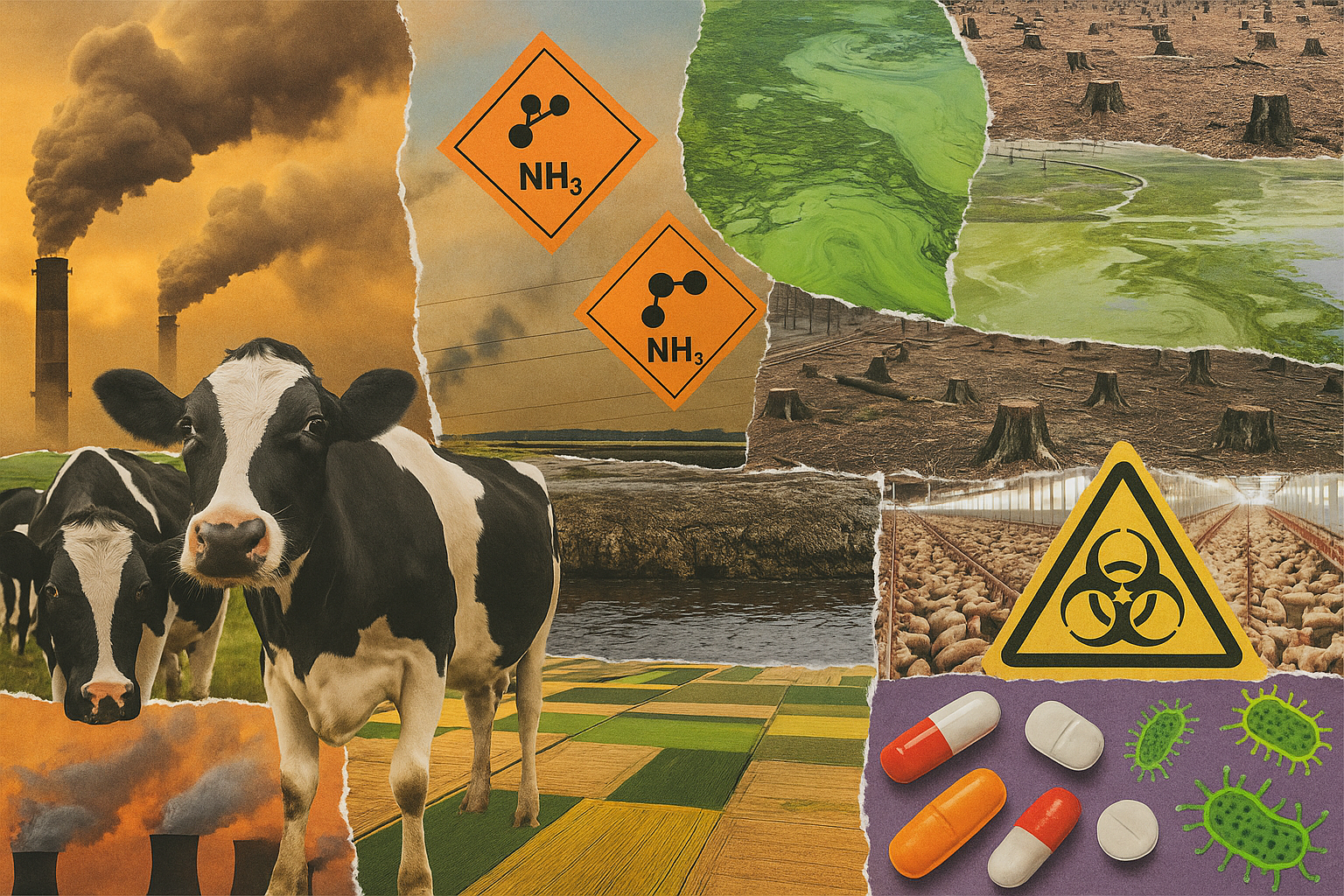




Big Ag has big impacts on our planet and our health.

Climate change is no longer up for debate. It’s not a hypothetical scenario posed by scientists about what’s to come—it’s here.
Global sea ice is nearing an all-time low. The past two years have been the hottest on record. Tropical storms, wildfires, climate-related deaths are rising.
Humans are rapidly running out of time to make fundamental changes and address this trend. Big Ag is one of the primary industries holding us back. Here are the top 10 ways factory farms put our planet at risk.
1. Greenhouse gas emissions
By now, you’ve likely heard the term “greenhouse gas.” It’s a catch-all for the various gases humans emit into the atmosphere to absorb and trap heat. This “greenhouse effect” upsets our planet’s delicate balance and contributes to climate change.
The agricultural sector is responsible for about one-third of global greenhouse gas emissions. Animal agriculture accounts for nearly 60% of those emissions, double the amount from raising fruits and vegetables.
2. Methane emissions
While carbon dioxide (CO2) is the poster child of greenhouse gases, methane (CH4) is its angrier cousin. Methane doesn’t last in the atmosphere as long as carbon, but it’s far more potent at trapping heat—20 to 80 times so.
Agriculture is the top producer of methane, a result of livestock belching and manure. Waste emissions can be mitigated on small, sustainable farms. However, with tens of millions of cows raised on densely packed factory farms, the sheer animal waste is unmanageable, and methane emissions soar.
3. Nitrous oxide emissions
Known commonly as “laughing gas,” nitrous oxide (N2O) is frequently omitted in conversations about greenhouse gases. It shouldn’t be, because it’s not just found in dentists’ offices. In fact, Big Ag is responsible for nearly 75% of human-caused N2O emissions—due to the industry’s overuse of synthetic fertilizers and management of manure, among other contributions.
Nitrous oxide is almost 300 times more potent than CO2, and stays in the atmosphere for more than a century.
4. Deforestation
Agriculture drives the majority of deforestation, the process in which large swaths of tropical rainforests are cleared to make way for grazing cows, and to grow crops—mostly used to feed animals.
Not only does deforestation kill off entire species, it also exacerbates climate change by erasing crucial “carbon sinks.” These are resources like tropical rainforests and oceans that absorb great quantities of carbon, helping to keep greenhouse gases out of the atmosphere.
5. Water pollution
Agriculture is the leading cause of water pollution throughout the world. Factory farms use hundreds of millions of pounds of herbicides and pesticides, and produce over a billion tons of manure annually. The harmful toxins and chemicals from this waste leach into groundwater, and flow into lakes, rivers, and eventually the ocean.
Agricultural runoff is chock-full of harmful, potentially fatal pathogens. Fertilizer is also packed with nutrients that create “toxic algal blooms,” depleting oxygen levels, killing aquatic creatures, and harming humans.
6. Air pollution
Beyond greenhouse gases, factory farms propel many other harmful substances into the air. Animal waste, in particular, pollutes the air with ammonia and hydrogen sulfide.
This costs human lives. Researchers estimated in 2021 that food production in the US alone results in more than 15,000 air-quality related deaths. They attributed 80% of those deaths to animal-based food production.
7. Water consumption
While billions of people around the world live with water scarcity, the agricultural industry accounts for a shocking 70% of this precious resource. Around 20% of the planet’s freshwater supply is used on animal agriculture. Virtually all farmed animals live on factory farms, and are fed diets of soy and corn. Those crops are 43 times more water intensive than the animal feed on more humane farms.
8. Land usage
We’ve talked a lot about how much of the planet’s resources Big Ag takes in, and the harmful things it pumps back out. How about simply how much of the planet agriculture takes up?
Staggeringly, nearly half of Earth’s inhabitable land is used for agriculture. The majority of that land—around 80%—is used for raising animals and growing crops to feed those animals. This is simply unsustainable.
9. Risk of pandemic
While COVID-19 has become a manageable reality of life, experts expect that we will experience another pandemic within most of our lifetimes, a likelihood driven by factory farming.
Big Ag is expanding into once remote parts of the world, where farmed animals are more likely to contract disease from foreign species. Disease spreads quickly on densely packed, squalid factory farms. Just as COVID-19 did, these viruses can mutate and jump from animal hosts to humans, especially those working on farms.
10. Antibiotic resistance
Farm overuse of antibiotics goes hand-in-hand with the cramped, unhealthy conditions on CAFOs. In an effort to curb the spread of disease, factory farmers may treat animals very liberally with antibiotics. However, due to this overuse, bacteria and other germs are changing to survive antibiotic treatment, meaning that bacterial infections in animals and humans alike are becoming harder—and in some cases impossible—to treat.
We need to act
It’s clear. Factory farms have got to go. Not only are they the source of immense suffering and cruelty for innocent, sentient animals—these facilities are also a direct threat to the future of the planet, and all who inhabit it.
If you would like to join the ever-growing team of people standing up to the injustices of industrialized agriculture, consider getting involved with The Humane League, where you can help create a more sustainable, compassionate for animals and humans alike.





